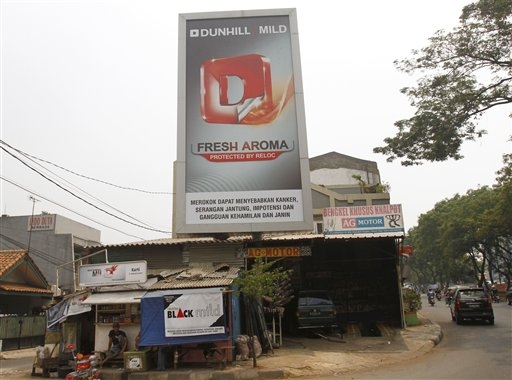
JAKARTA, Indonesia (AP) — Indonesian men rank as the world's top smokers, with two out of three of them lighting up in a country where cigarettes cost pennies and tobacco advertising is everywhere.
A survey released Tuesday found that 67 percent of all males over 15 years old smoke. The sprawling archipelago ranked second only to Russia overall with a rate of 35 percent compared to 39 percent, respectively.
"We have failed in protecting our people," said Health Minister Nafsiah Mboi, commenting on the rate of male smokers jumping from 53 percent since 1995. "We have been defeated by the tobacco industry ... we don't want this, we cannot accept this because our job is to protect people from cigarettes."
More than 8,000 people participated in the study last year, which is part of a global series of surveys taken in 15 countries with heavy tobacco use and supported by the World Health Organization and the U.S. Centers for Disease Control and Prevention. It also found a high rate of Indonesians were subjected to second-hand smoke at work, home and in public places.
Mboi said she was particularly alarmed to learn that nearly 80 percent of Indonesians are exposed to smoke at home.
"How is the number of parents smoking at home with kids so high? It means that they are damaging their children's lungs, whether intentionally or not," she said. "As the health minister, I am ashamed to let this condition continue."
Indonesia has long been criticized for its lack of tobacco controls. It is one of a remaining handful of countries that has failed to sign the WHO's tobacco treaty. Giant billboards promote cigarettes and commercials run on television and before movies in theaters. Local and multinational tobacco companies also routinely sponsor sporting events and concerts — advertising that has long been banned in many countries.
Most Indonesian men crave kreteks, a pungent mixture of tobacco and cloves, but brands such as Marlboro, produced by U.S.-based Philip Morris International, have also gained in popularity. About 3 percent of women smoke in the country.
Health regulations passed in 2009 call for a number of tighter tobacco controls, including bans on advertising and smoking in public places, but they have yet to be implemented by the government.
"It's just sitting there," said Mark Hurley of the Washington-based Campaign for Tobacco-Free Kids, who attended the report's launch in Jakarta. "I think if there was high-level approval, the health regulations would have been passed a long time ago."
Smoking-related illnesses kill at least 200,000 annually in Indonesia, which has a population of nearly 240 million. About a quarter of Indonesian boys aged 13 to 15 get hooked on cigarettes that sell for about $1 a pack or as little as a few cents per stick, according to WHO. The latest national survey, however, only assessed smoking among adults.
Indonesia's tobacco industry employs millions in the world's fifth-largest cigarette-producing market. About 6 percent of the government's revenue comes from cigarette taxes, and a powerful tobacco lobby has blocked past regulation attempts, including a move to ban TV ads.
Indonesian cigarettes are cheap by regional standards, with taxes less than 40 percent. Tobacco farmers have held massive street protests to denounce any push for higher tariffs or tighter restrictions.
The series of tobacco surveys included Bangladesh, Brazil, China, Egypt, India, Mexico, the Philippines, Poland, Russia, Thailand, Turkey, Ukraine, Uruguay and Vietnam.